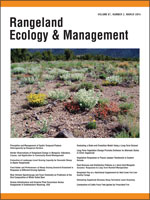The goal of our study was to document traditional steppe herders' perception and management of spatial and temporal heterogeneity of forage availability of their seminatural pastures. Ninety-two herders living in the Hortobágy saline steppe, Hungary, Central Europe were interviewed, and participatory observation was used to understand herding and habitat improvement techniques. The herders recognized 47–66 habitat types (mostly grassland types), and listed at least 90 plant species important for grazing. They have a nuanced knowledge of the intra- and interannual variations of forage quality and quantity. They perform very strong and well-planned herding practices. Daily spatial pattern of grazing is, however, often opportunistic and flexible, but has a more-or-less regular year-round cycle, in which marshes and stubbles provide forage in drought periods. Reciprocal learning and continuous communication between the herder and his driving dogs and livestock strongly influence grazing pattern. Herders manage and improve different habitats of their pastures differently by traditional and, less frequently, modern methods. The main method is grazing supplemented by manuring, burning, and removal of spiny weeds. Traditional knowledge of herders could be effectively used in evidence-based conservation and pasture management of European saline steppes; e.g., the reintroduction of some old herding techniques (opportunistic pasture use, grazing of marshes, and burning). Herders' knowledge could also help the fine-tuning and local adaptation of European agri-environmental regulations (e.g., how to balance subsidies for hay-making and grazing in saline steppes). More research is needed, however, on the ecological effects of different traditional grazing techniques, e.g., rotation, manuring, and burning. In general a more complex socio-ecological understanding of the internal and external factors affecting adaptation of the Hortobágy herders to changing environment, society, and European Union policies is needed.
How to translate text using browser tools
1 March 2014
Perception and Management of Spatio-Temporal Pasture Heterogeneity by Hungarian Herders
Zsolt Molnár
ACCESS THE FULL ARTICLE

Rangeland Ecology and Management
Vol. 67 • No. 2
March 2014
Vol. 67 • No. 2
March 2014
fodder availability
grazing distribution
nature conservation management
pastoralists
pasture management
precision herding




